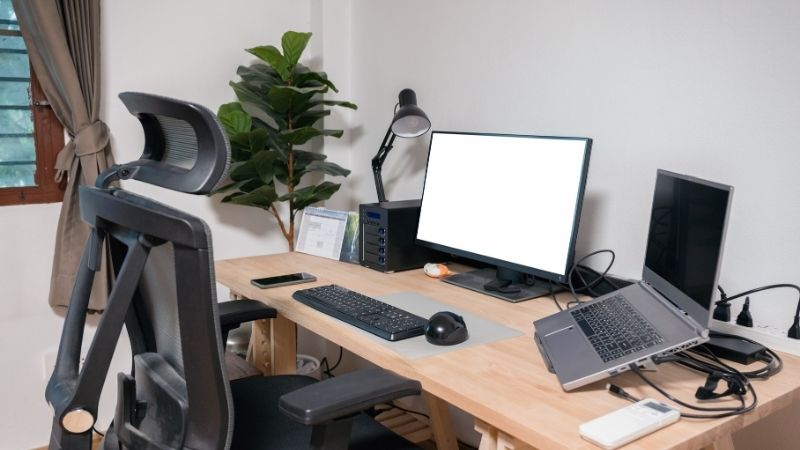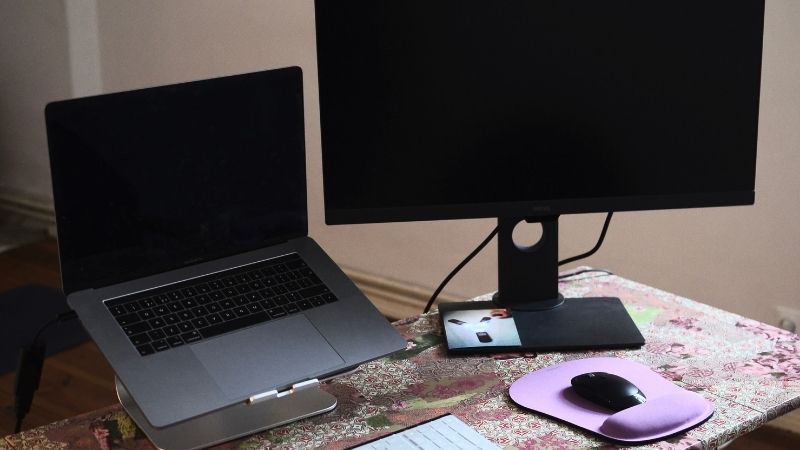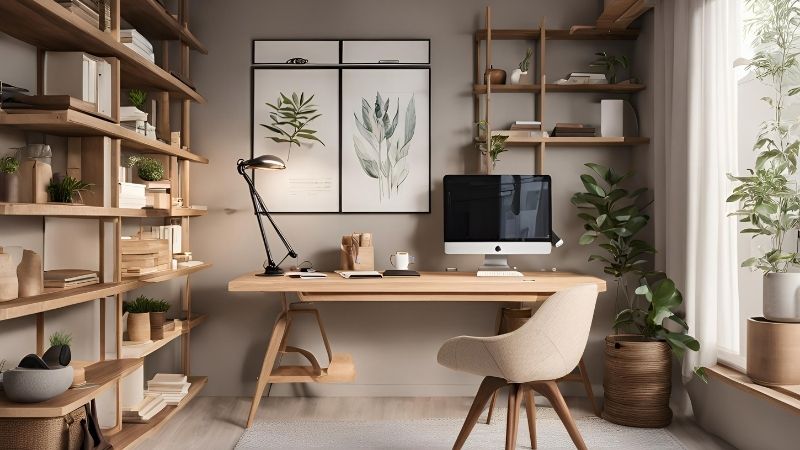Working from home has become more popular than ever, but with the perks of flexibility comes the challenge of creating a space that’s both functional and comfortable. You might be sitting in your home office for hours on end, but how can you make sure your space doesn’t just look good, but also supports your health and well-being? The answer is ergonomic design!
With the right ergonomic solutions, you can upgrade your home office to not only enhance your productivity but also make it a stylish, comfortable, and healthy environment. We’ve got you covered with top tips and trendy solutions for a truly ergonomic office makeover!
This post contains carefully selected links to products we love. If you choose to purchase through them, we may earn a small commission at no extra cost to you.
1. Adjustable Chairs: The King of Comfort and Style

When it comes to ergonomic design, your chair is a non-negotiable. An adjustable chair is a game-changer—both for your posture and for your comfort. A chair that offers customizable features like seat height, armrests, lumbar support, and tilt will keep you comfortable for hours, while also reducing strain on your back, neck, and shoulders.
Popular Picks:
- Herman Miller Aeron Chair: This iconic ergonomic chair is loved for its breathable mesh fabric and customizable features. It promotes good posture, and its sleek design adds a modern touch to any office. 👉Check out this top-rated ergonomic chair – your back will thank you!
- Secretlab Titan Evo 2022: Originally designed for gamers, this chair offers adjustable lumbar support, a recline feature, and a sturdy build that’s perfect for long hours of work. 👉We recommend this ergonomic chair for a balance of comfort and style.
Pro Tips:
- Opt for a chair with lumbar support to ensure your lower back is properly supported. This can help avoid discomfort and long-term back issues.
- Choose a chair with adjustable armrests. Armrests that are too high or low can lead to strain in your shoulders and wrists.
2. Desks That Work for You: Adjustable Height = Healthier You

A desk is more than just a surface to pile papers on. An ergonomic desk should be adjustable so you can alternate between sitting and standing. Standing desks not only help improve posture but can also boost energy and productivity. Plus, who doesn’t love the idea of being able to stand up after hours of sitting?
Popular Pick:
- Uplift V2 Standing Desk: This desk is sturdy, sleek, and easily adjustable with the push of a button. Whether you're typing away sitting down or standing tall, this desk has you covered. 👉 Take a look at this stylish and functional standing desk for the ultimate ergonomic upgrade!
Pro Tips:
- When standing, make sure your screen is at eye level to avoid neck strain. You can adjust the monitor height with a simple monitor stand to ensure the proper ergonomics.
- Aim for a desk height that allows your elbows to be at a 90-degree angle when typing.
3. Monitor Stands: Keep Your Screen at Eye Level

A monitor stand is an often-overlooked item in an ergonomic home office setup, but it’s crucial for maintaining proper posture. Having your screen at eye level can help you avoid neck and back strain.
Popular Picks:
- 3M Adjustable Monitor Stand: This stand is adjustable, so you can find the perfect height for your monitor. It also includes a drawer for extra storage. 👉 Check out this adjustable stand to keep your workspace clutter-free and your neck pain-free!
- VIVO Dual Monitor Desk Stand: If you use multiple monitors, this stand is a great solution to keep both screens at eye level while saving desk space. 👉 Get this dual monitor stand to enhance your work efficiency and comfort.
Pro Tips:
- Your screen should be directly in front of you, with the top of the monitor about 1-2 inches above your eye level. This encourages proper neck posture.
- Keep the screen about an arm’s length away from your eyes to avoid eye strain.
4. Keyboard and Mouse: Ergonomics at Your Fingertips

It’s not just about the chair or the desk—your keyboard and mouse play a huge role in your ergonomic setup. Both should be positioned to reduce strain on your wrists and hands.
Popular Picks:
- Logitech Ergo K860 Wireless Keyboard: This curved, split design keyboard helps keep your wrists in a natural position, reducing strain and fatigue. 👉 Discover this ergonomic keyboard designed for comfort and productivity.
- Microsoft Sculpt Ergonomic Mouse: The design of this mouse encourages a more natural hand position, keeping your wrist in a neutral posture. 👉 Check out this ergonomic mouse for smooth navigation with less wrist strain.
Pro Tips:
- Position your keyboard and mouse so your forearms are parallel to the floor. This helps minimize stress on your wrists.
- Consider a wrist rest for additional support, particularly if you type a lot during the day.
5. Lighting: Bright Ideas for Your Office

Good lighting can drastically reduce eye strain and headaches, so don’t overlook it. Your desk should be well-lit, but it’s equally important to ensure your workspace has a balance of ambient, task, and natural lighting.
Popular Picks:
- BenQ ScreenBar Plus e-Reading Lamp: This lamp is designed to minimize screen glare while providing even, soft light for your workspace. 👉 Shop this amazing task light to illuminate your desk without adding harsh glare.
- LIFX Smart Light Bulb: Change the ambiance of your office with adjustable lighting. Whether you want cool, bright lights or soft, warm ones, this bulb has you covered. 👉 Check out these smart bulbs to set the perfect lighting for your work sessions.
Pro Tips:
- Natural light is best, so place your desk near a window if possible. Avoid harsh overhead lights that can cause glare on your screen.
- Invest in adjustable desk lamps that offer soft, focused light, reducing eye strain.
6. Flooring: Cushion Your Feet

An ergonomic home office isn’t complete without thinking about the floor beneath your feet. Hard floors can lead to leg fatigue, especially during long working hours. Adding an anti-fatigue mat can help provide support and comfort.
Popular Picks:
- Topo by Ergodriven Anti-Fatigue Mat: Designed to keep your body in motion while you stand, this mat promotes blood circulation and reduces discomfort. 👉 Check out this anti-fatigue mat for ultimate comfort while standing.
- ComfiLife Anti-Fatigue Mat: A sleek and supportive mat that cushions your feet and encourages better posture while standing. 👉 Grab this anti-fatigue mat to enhance your standing desk setup.
Pro Tips:
- Use a cushioned mat if you stand for extended periods. It helps reduce pressure on your legs, feet, and lower back.
- Ensure your chair rolls smoothly across the floor to prevent unnecessary strain when moving.
7. Declutter Your Desk: The Zen of a Tidy Workspace

Clutter can increase stress levels and reduce productivity. Keep your desk organized by opting for ergonomic storage solutions that don’t take up much space but still keep your essentials close.
Popular Pick:
- YAMAZAKI Home Desk Organizer: This minimalist design organizer helps tidy up your space while adding a touch of elegance. 👉 Shop this stylish desk organizer to keep your office neat and chic.
Pro Tips:
- Opt for vertical storage to save desk space. Shelves or wall-mounted organizers are great ways to keep your desk clutter-free.
- Keep only what you need within reach to maintain a calm, focused workspace.
Wrapping It Up
Creating an ergonomic home office doesn’t mean sacrificing style for comfort. With the right furniture and thoughtful design, you can have both. From adjustable chairs and desks to clever monitor stands and comfy floor mats, there are countless solutions to keep you healthy, productive, and stylish. So why not give your home office a makeover today?
Remember, ergonomics is all about setting up your space to work for you. Make the changes that best suit your lifestyle and workspace, and you’ll see a huge improvement in your workday. For more tips, inspiration, and product recommendations, follow Decormate on Pinterest!